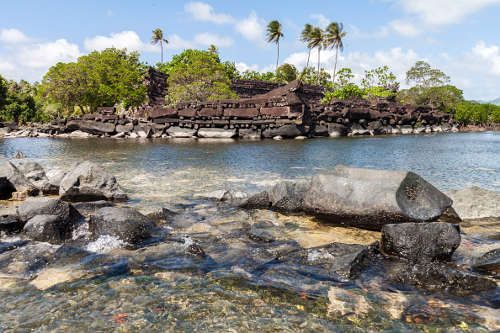Balance. Purpose. Enlightenment.
Lemuria
Pohnpei and Nan Madol
Venice of the Pacific
Scattered throughout the length and breadth of the Pacific, both above and below water, are majestic monuments of such size and grandeur as to stagger the imagination. Mute, desolate, hoary with age, even the legends of the people native to these islands gave no indication as to who built them. Not all of them have been uncovered even today.
Consider Pohnpei in the Eastern Caroline Islands, twenty-three hundred miles south of Japan, just north of the equator. This island is barely capable of supporting the 34,000 inhabitants living there today without considerable ocean commerce with other countries, but on its southeastern shores lies a ruined, half submerged city called Metalanim (Nan Madol) consisting of ninety-two prehistoric, artificial islands surrounded by human-constructed canals. This complex covers eleven square miles—an area capable of housing more than a million people. Who were they, and what happened to them?

Because of its massive walls, earthworks, and temples, intersected by miles of artificial waterways, Metalanim has been called the “Venice of the Pacific.” These canals are from thirty to one hundred feet wide, containing locks that would hold a large ship (for reference, the Panama Canal is 110 feet wide). Could the original inhabitants of this metropolis have used humble canoes as their only means of conveyance?
In no sense was Metalanim built like our modern cities. The structures were built of basalt blocks weighing upwards of five tons each. What may still be seen of these ruins reveals no outstanding contribution to the sciences of engineering or architecture, but the builders had considerable experience with design and construction.
Seventeen hundred miles south of Hawaii and almost three thousand miles from Pohnpei lies Malden Island—waterless, barren, and uninhabited. Within a very restricted area, however, are observed the remnants of forty stone temples from which a paved highway—constructed of basalt blocks—vanishes beneath the waters of the Pacific. The style of architecture and masonry is identical with that on distant Pohnpei, yet there is no evidence of a quarry of any sort on the island.

